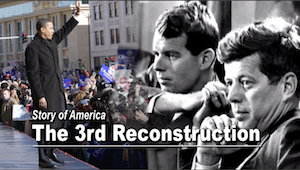
Each time there has been a demographic shift in America that threatens the existing balance of power, new election laws have appeared to try to insulate the electorate from the emerging population.
The most obvious demographic shift threatening the balance of power was emancipation. With it came the right to vote for African American men, which was decisive in Southern states where former slaves far outnumbered whites. This was considered unacceptable, and, starting in 1874, a wave of political violence and terrorism (until recently, celebrated as heroic terrorism) overthrew democratically elected governments and rigged elections in order to install voting restrictions and other practices which barred African Americans from voting in the South for 80 years.
Immigration has also prompted voting restrictions. Voter registration — something we take for granted today — was invented in 1820 by Pennsylvania aristocrats who began to fear that German immigrants might shift the balance of power. Under the new law, voter registration was required EACH YEAR in order to vote in a given election, and — get this — it was required only in Philadelphia and Pittsburgh where the German immigrants primarily settled. In the rest of Pennsylvania, voter registration was not required at all.
The state of New York passed a law in 1921 requiring an English literacy test in response to immigration waves that included Italians, Poles, Jews, and Slavs. New York also implemented a voter registration law that required people to register every year, and even moved election day to Saturday, the Jewish Sabbath. The Chinese Exclusion Act of 1882 not only prevented Americans of Chinese ancestry from voting, it prevented them from claiming birthright citizenship undermining the 14th amendment.
The current demographic shift, so often mentioned in politics today, first revealed itself in the 2000 census data. Soon after summary reports were released showing that America will soon become a minority majority country, a election lawyer appointed by President Bush to the US Department of Justice Voting Rights division launched a 5-year investigation to search for “voter fraud.” The operative, named Hans von Spakovsky, was able to find 26 cases of voter impersonation out of 173 million votes cast between 2002 and 2005. That’s not the kind of percentage that could undermine the “integrity” of an election, but, that didn’t stop the hysteria from spreading, particularly after the 2006 and 2008 elections where Asian, Latino, and African American voters played decisive roles. Television and radio productions created in the public a fear that voter fraud — and not demographic shift — explained electoral outcomes, which in turn helped to popularize the idea of voter ID laws. Politicians needed only to point to their constituents and say, “I’m responding to their very real fear,” even if the threat of in-person voter fraud wasn’t real at all.
Today, von Spakovsky works for the Heritage Foundation and you’ll never guess his job. He goes from state to state telling lawmakers how to implement new voting restrictions.
The United States had never had a voter ID law in its entire history when the 2000 census data came out. Today, 30 states have some form of voter ID requirement. And, just as voting laws are being manipulated to make it harder for the People to influence elections, campaign finance laws are being manipulated to make it easier for money to influence elections.
We could consider historic precedent as we interpret recent events like the “Citizens United” decision and new voting restrictions being passed in swing states like Ohio and North Carolina. Or we could limit our consideration to something we heard on television. We’re all free to make that choice, but it doesn’t hurt to know our history.
About the video above
President John F. Kennedy led our nation during a tumultuous period of violent backlash against the Civil Rights movement, and historian Carl M. Brauer argued that this era was the Second Reconstruction, a second attempt to make good on the promise of America, for all Americans, in the South as well as the North.
In January of 2013, we traveled to Durham, NC and met with Rev. Dr. William Barber — President of the North Carolina NAACP — to ask him why he thinks America is so divided today. He offered this historical framework, in which the America that twice elected President Obama is embroiled in a Third Reconstruction, with a similar, but less violent, political backlash:
In Rev. Dr. Barber’s view, we are currently going through the third reconstruction. The first Reconstruction took place after the Civil War. Fusion politics — a governing coalition including Lincoln Republicans, freedmen and former slaves, and populists — made it possible for former slaves to become business, community, and political leaders. But fusion politics was snuffed out by a violent backlash, and replaced by Jim Crow laws that blocked African Americans from voting through poll taxes, impossible “tests,” and terrorism.
In the 1960s, there was another attempt at reconstruction, better known as the Civil Rights Movement. The progress we made was met with another violent backlash, culminating in the assassinations of Martin Luther King, Jr. and Robert F. Kennedy in 1968.
Rev. Dr. Barber identifies the possibility of a third reconstruction, one that could actually succeed, with the launch of Barack Obama’s campaign for president in 2008. Once again, this attempt at fusion politics has been met with a hateful backlash. The backlash against integration, equality, and trans-racial governing coalitions has, in all three instances, included attacks on voting rights of African Americans and other minorities. Rev. Barber believes that change is inevitable because of demographic shifts in America and the effectiveness of fusion politics.
Please support Story of America with a tax deductible donation.
